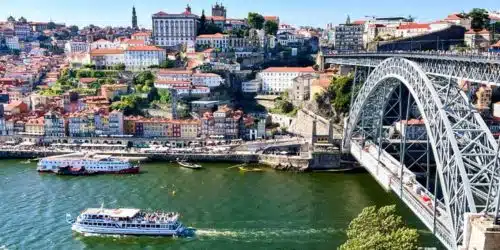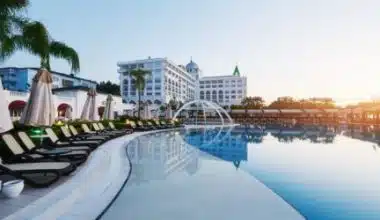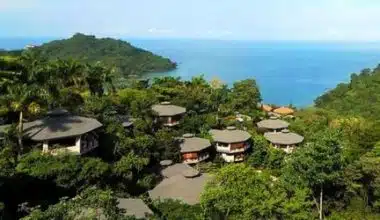A trip to Portugal is traveling to the country of Portugal for leisure, tourism, or any other purpose. It means planning a journey to explore the country, experience its culture, visit its attractions, and enjoy its offerings such as food, landscapes, and historical sites. Portugal offers a variety of captivating destinations, including vibrant Lisbon, historic Porto, fairytale-like Sintra, picturesque Algarve beaches, charming Aveiro, ancient Coimbra, the lush Douro Valley, and the natural beauty of Madeira and the Azores.
Trip To Portugal
A trip to Portugal means traveling to and visiting Portugal. It can be any type of travel, such as tourism, business, or personal travel. The purpose of the trip can vary depending on the individual’s needs or interests. Portugal is a beautiful country with a rich culture, history, and cuisine.
Important Information To Know When Planning A Trip To Portugal
Here are some important things you should know when planning a trip to Portugal,
#1. Passport and Visa Requirements
If you’re a US citizen, you don’t need a visa to enter Portugal for stays up to 90 days. However, your passport should be valid for at least three months beyond your intended departure date and should have at least two blank pages.
#2. Language
The official language of Portugal is Portuguese, but many people speak English, especially in tourist areas. It’s always a good idea to learn a few basic Portuguese phrases to help you get around and communicate with locals.
#3. Currency
The official currency of Portugal is the Euro. You can exchange your currency at banks, exchange offices, or ATMs throughout the country. Credit cards are widely accepted, but it’s always a good idea to have some cash on hand, especially for smaller purchases.
#4. Climate
Portugal has a Mediterranean climate with mild, wet winters and hot, dry summers. The best time to visit Portugal is in the spring (March to May) or fall (September to November), when the weather is mild and the crowds are smaller.
#5. Transportation
Portugal has a well-developed transportation system, including buses, trains, and a metro system in Lisbon and Porto. Taxis and rental cars are also widely available. If you plan to rent a car, be aware that Portugal has toll roads, and you’ll need to purchase a toll device or pay the toll manually.
#6. Safety
Portugal is generally a safe country for tourists, with a low crime rate. However, pickpocketing and bag-snatching can be a problem in crowded tourist areas, so it’s important to be aware of your surroundings and keep your belongings secure.
#7. Food and Drink
Portuguese cuisine is known for its fresh seafood, grilled meats, and flavorful stews. Wine is also a big part of Portuguese culture, with many excellent local varieties available. Be sure to try the famous pastel de nata (custard tart) and sip on a glass of port while you’re there.
#8. COVID-19 Restrictions
Portugal has implemented measures to control the spread of COVID-19. It’s important to check the latest travel restrictions and requirements before you go, including any testing or vaccination requirements.
#9. Health and Insurance
Make sure you have travel insurance that covers medical expenses. The European Health Insurance Card (EHIC) may also be useful.
#10. Tipping
Tipping is common but not mandatory. A small tip (5-10%) in restaurants is appreciated if service isn’t included in the bill.
Beautiful Destinations To Visit In Portugal
There are many beautiful and interesting places to visit in Portugal.
Here are some of the top destinations:
#1. Lisbon
Portugal’s capital city is a vibrant and historic destination, with stunning architecture, museums, and lively nightlife.
#2. Porto
Located in the north of Portugal, Porto is famous for its port wine and charming historic center.
#3. Algarve
Portugal’s southernmost region is known for its stunning beaches, warm weather, and beautiful coastline.
#4. Sintra
This UNESCO World Heritage Site is located just outside of Lisbon and is known for its stunning palaces and castles.
#5. Coimbra
This historic university town is located in central Portugal and is known for its beautiful architecture and cultural attractions.
#6. Madeira
This beautiful island located off the coast of Portugal is known for its stunning landscapes, hiking trails, and subtropical climate.
#7. Évora
This historic city in the Alentejo region of Portugal is known for its well-preserved Roman ruins and medieval architecture.
#8. Funchal
The capital city of Madeira is a beautiful destination with a rich history and culture, as well as stunning gardens and parks.
#9. Guimarães
This historic city is known as the birthplace of Portugal and is a UNESCO World Heritage Site.
#10. Peneda-Gerês National Park
This beautiful national park in the north of Portugal is known for its stunning landscapes, hiking trails, and wildlife.
Trip To Portugal And Spain
A trip to Portugal and Spain is a travel itinerary that includes visiting both countries during the same trip. This can involve flying into one country and out of the other, or traveling overland between the two countries. A trip to Portugal and Spain can offer a diverse range of cultural and historical experiences, as well as a chance to sample the local cuisine and wine. The length and specific itinerary of a trip to Portugal and Spain can vary depending on the traveler’s interests and preferences.
Things To Consider When Planning A Trip To Portugal
Here are some things to consider when planning a trip to Portugal and Spain
#1. Decide on the Length of your Trip
Decide on the length of your trip and which cities or regions you want to visit. Some popular cities to consider in Portugal include Lisbon, Porto, and the Algarve region. In Spain, popular cities include Madrid, Barcelona, Seville, and Valencia.
#2. Book a Tour Package
Consider booking a guided tour package that covers both countries. Many companies offer tours that visit both Portugal and Spain, such as Grand Circle Travel, Trafalgar, and Tauck.
#3. Consider Transportation
If you prefer to plan your itinerary, consider flying into one country and out of the other to save time and money on transportation.
#4. Check Visa Requirements
Be aware of the entry and visa requirements for both countries, especially if you are a non-European Union citizen.
#5. Plan for Activities
Pack for the weather and activities you plan to do. Portugal and Spain both have a Mediterranean climate, but the weather can vary depending on the season and region.
#6. Try Out the Local Cuisine
Try the local cuisine in both countries, such as paella in Spain and bacalhau (salt cod) in Portugal. Both countries are also known for their wine, so be sure to sample some local varieties.
#7. Sightseeing
Be prepared to do a lot of walking and sightseeing, as both countries have many historic and cultural attractions to explore.
Trip To Portugal Itinerary
A Trip to Portugal Itinerary is a detailed plan or schedule that outlines the activities, destinations, and experiences you intend to have during your visit to Portugal. It helps you organize your travel days efficiently, ensuring that you make the most of your time in the country. The itinerary provides information about which places to visit, when to visit them, how to get there, and what to do at each location. It can include details about accommodations, transportation, sightseeing, dining, and any other relevant aspects of your trip.
Here’s a sample 7-day itinerary for a trip to Portugal, focusing on some of the key destinations and experiences. You can adjust it based on your interests and the time you have available:
#Day 1: Arrival in Lisbon
– Arrive in Lisbon, the capital of Portugal.
– Check into your accommodation and freshen up.
– Explore the historic neighborhoods of Alfama, Baixa, and Bairro Alto.
– Enjoy a traditional Portuguese dinner in a local restaurant.
#Day 2: Lisbon
– Visit Belém Tower, Jerónimos Monastery, and the Monument to the Discoveries.
– Try the famous Pastéis de Nata at a local bakery.
– Take a tram ride on Tram 28 to explore the city’s charming streets.
– Sunset at Miradouro da Senhora do Monte for Panoramic Views.
#Day 3: Sintra Day Trip
– Take a day trip to Sintra, a fairytale town with colorful palaces and castles.
– Visit Pena Palace, Moorish Castle, and Quinta da Regaleira.
– Return to Lisbon in the evening.
#Day 4: Porto
– Travel to Porto by train or bus.
– Explore the Ribeira district along the Douro River.
– Visit Livraria Lello (a stunning bookstore) and Clérigos Tower.
– Enjoy a traditional Francesinha sandwich for dinner.
#Day 5: Porto and Douro Valley
– Take a guided tour of a Port wine cellar.
– Consider a day trip to the Douro Valley for wine tasting and scenic views.
#Day 6: Coimbra
– Travel to Coimbra, a historic university city.
– Visit the University of Coimbra and its stunning library.
– Explore the Old Cathedral and stroll through the medieval streets.
#Day 7: Aveiro and Beaches
– Head to Aveiro, known as the Venice of Portugal.
– Take a boat ride through the canals and try the local sweets, ovos moles.
– Relax at a nearby beach, such as Praia da Costa Nova.
– Return to Lisbon or depart from Porto, depending on your flight.
Trip To Portugal Cost
A trip to Portugal can vary depending on various factors, such as the time of year, the duration of the trip, the standard of accommodation, and the activities planned.
Cost Expendable For A Trip To Portugal
Here is a breakdown of the cost of a trip to Portugal based on the search results:
#1. Accommodation
Hotels in Portugal range from $45 to $199 per night, while vacation rentals cost $140 to $480 per night for the entire home. Budget travelers can find cheaper options in hostels or budget hotels.
#2. Transportation
The cost of transportation in Portugal varies depending on the mode of transport. A one-way ticket for local transport costs around €1.50, while a taxi ride starts at around €3.50. Renting a car costs around €20-€50 per day.
#3. Food and Drinks
The average cost of food and drinks in Portugal is around €30-€40 per day. Budget travelers can find cheaper options in local cafes and restaurants.
#4. Activities
The cost of activities in Portugal varies depending on the type of activity. Some activities, such as visiting museums and historical sites, may have an entrance fee. Other activities, such as hiking and beach-going, are free.
#5. Visa Fees
Visitors to Portugal from certain countries may require a visa to enter the country. The cost of a visa varies depending on the type of visa and the country of origin.
What Is The Best Month To Travel To Portugal?
The best time to visit Portugal is either in spring (March-May) or fall (September-October). These seasons offer mild weather, long days, and fewer crowds. However, the peak tourist season is from June to August, which may result in higher prices and larger crowds. Ultimately, the best month to travel to Portugal depends on individual preferences and priorities.
How Expensive Is It To Travel To Portugal?
Portugal is considered to be an affordable destination for travel and vacation. A daily budget of around $136 ($50 for budget travelers) is sufficient for a trip to Portugal. However, costs can range from $850-$1200 per person for a weeklong stay in the summer to $106 per person per day for the cheapest trip to Portugal. The cost of a trip to Portugal can vary depending on various factors such as the purpose of travel, travel season, and personal preferences.
Is Portugal Cheap Or Expensive To visit?
Portugal is a relatively cheap country to visit, as its cost of living is 46% cheaper than in the United States. Budget-friendly travel planning sites suggest that a daily budget of around $136 ($50 for budget travelers) is sufficient for a trip to Portugal, and food and accommodation are available at affordable prices.
Do I Speak English In Portugal?
Yes, English is widely spoken in Portugal, especially in the larger cities and in the Algarve. Many people in Portugal speak at least one foreign language, with English being the most widely spoken foreign language. Portugal is also considered to be the 9th most proficient country in the world when it comes to speaking English as a second language.
Should I Go To Portugal Or Italy?
Both Portugal and Italy are great travel destinations with unique attractions and features. The choice between the two depends on personal preferences and travel goals. Portugal is considered to be a more affordable travel destination, while Italy is known for its rich culture, food, and history.
What Time Of Year Is Portugal’s Cheapest?
The cheapest time to visit Portugal is outside of the summer months and major holidays, such as Christmas and Easter. Low season months of November to March are also considered cheaper times to visit. Portugal is known to offer a lower cost of living compared to many other Western European countries.
Which Month Is Coldest In Portugal?
January is the coldest month in Portugal , with average low temperatures ranging from 8.3C (47F) in Lisbon to 12C (54F) in the Algarve .
Conclusion
A Trip to Portugal and Spain is traveling to both countries for a combined travel experience. It involves visiting various destinations in both Portugal and Spain during the same trip. This kind of journey allows you to explore the unique cultures, landscapes, and attractions of both countries, enjoying the diversity of experiences that each has to offer. You might start in one country and then travel to the other, or you could move back and forth between the two depending on your itinerary. It’s an opportunity to enjoy the richness and local customs of both Portugal and Spain.
A trip to Portugal itinerary is a planned route or schedule of activities for visiting Portugal. It lays out a plan for the duration of the trip, including the places to visit, activities to engage in, and the time allocated for each activity. An itinerary for a trip to Portugal may include visits to popular tourist destinations such as Lisbon, Porto, Sintra, the Algarve region, and the Douro Valley, among other places. It can also include day trips to nearby attractions and accommodations for the duration of the trip. The itinerary can be tailored to suit the interests of the traveler, the duration of the trip, and the budget available.
- HOW TO PLAN A TRIP: Detailed Guide
- BEST PLACES TO SOLO TRAVEL
- BEST SOLO TRIPS DESTINATIONS IN 2023
- 21 TOP BUDGET TRAVEL TIPS






